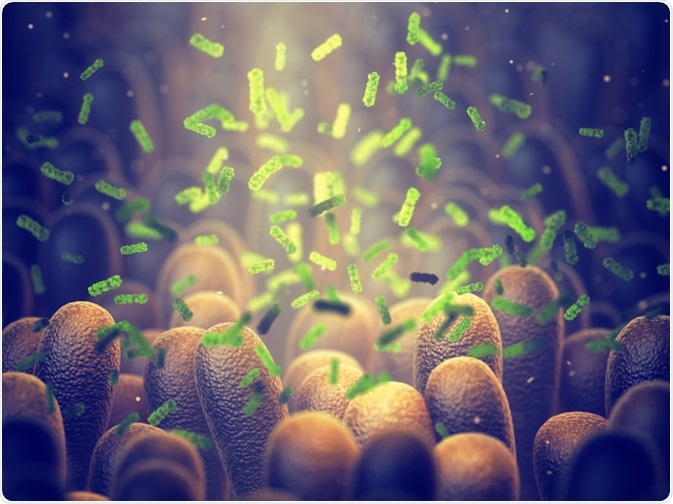Recent research is uncovering the link between exposure to semi-volatile organic compounds (SVOCs) and changes in the gut microbiome. Scientists are particularly interested in how these products impact the bacteria in children’s guts, with new studies hinting that certain bacteria may be useful in the bioremediation of the infant digestive tract.
 Image Credit: nobeastsofierce / Shutterstock.com
Image Credit: nobeastsofierce / Shutterstock.com
SVOCs Change the Bacteria in the Microbiome
A team of researchers based at Duke University conducted what is considered to be the most comprehensive study of how semi-volatile organic compounds (SVOCs) impact the gut microbiome in human children.
In a paper recently published in the journal Environmental Science & Technology Letters, the team describes how their results have revealed a correlation between SVOCs and the levels of different bacteria and fungi in the human digestive tract.
Their findings also demonstrated that certain SVOCs may impact these species differently, with some of them being detrimental and others beneficial. Additionally, the study’s results suggested that halogenated compounds, in particular, may introduce bacteria into the human gut that is not native to it, a specific niche of species that feed off the compounds.
Interestingly, the researchers found specific species of bacteria that are used to remove chlorinated solvents from the soil in the process of soil bioremediation. The researchers hypothesized that the bacteria appear in the gut for the same purpose, to detoxify and remove chlorines.
The Link Between The Gut Microbiome In Children And Long-Term Health
The team at Duke University designed a study to investigate the effect of SVOC exposure on the gut microbiome. Previously, it has been understood that SVOCs have the potential to induce various negative and even positive health outcomes. However, the nature of the relationship between SVOCs and the microbiome has remained unclear.
Given that numerous household products and building materials contain SVOCs, which have been shown to slowly evaporate into the air and settle onto dust particles and water droplets, it is important to understand how they impact human health in order to protect the population from potential detrimental effects.
In particular, scientists are interested in understanding how these compounds affect the microbiome of children as they are considered to be at greater risk of exposure due to time spent paying on the floor where SVOCs are known to accumulate, and due to being more vulnerable to the impact of environmental stressors. Additionally, the health of the microbiome in children may well be linked with overall long-term health.
A growing body of evidence is elucidating the link between the human gut microbiome and health, with many recent studies findings links between the microbiome and various diseases including Alzheimer’s and cancer, neurodevelopment disorders such as autism, and even mental health illnesses including depression.
Infant health is particularly known to be associated with the balance of bacteria and fungi growing in the digestive tract. A few previous studies have revealed that exposure to certain SVOCs certainly has an impact on the microbiome of children, although they have been limited in the range of compounds they have investigated.
The latest study aimed to discover which classes of SVOC are associated with negative impacts on the gut microbiome. Uncovering SVOCs with negative health implications would help encourage actions to reduce their use in certain products and protect those at risk of consistent exposure.
To uncover potentially dangerous SVOCs, the team at Duke University recruited 80 children between the ages of three and six. They collected samples of blood and urine to measure the levels of numerous SVOCs circulating in the children’s bodies. The team then used these measurements to analyze the relationship between certain SVOCs and bacteria and fungi in the gut microbiome.
The analysis revealed a total of 29 SVOC compounds present in over 95% of the samples. Then analysis also found links between these SVOCs and the levels of 61 bacteria and 24 fungi. Through further analysis of these relationships, the team was able to make two key conclusions from their data.
Firstly, they determined that an abundance of halogenated SVOCs in the children’s bodies was associated with the presence of some unusual bacteria and fungi in their digestive tract. In addition, the team also concluded that SVOCs could have a negative or positive impact on the gut microbiome.
Future Studies on the Impact of SVOCs on the Gut Microbiome
Further research is needed to reveal the nature of the relationship between SVOCs and the gut microbiome in greater detail. Further study could highlight SVOCs that pose a particular risk to human health and may be instrumental in regulating their use in consumer products and building materials.
Other than emphasizing this area of research that needs more attention, the recent study was successful in developing a simple method of measuring SVOC exposure via sequencing a microbiome's genetic signature. This technique may prove essential in future studies of SVOCs and the gut microbiome.
Sources
Gardner, C., Hoffman, K., Stapleton, H. and Gunsch, C., 2020. Exposures to Semivolatile Organic Compounds in Indoor Environments and Associations with the Gut Microbiomes of Children. Environmental Science & Technology Letters,. https://pubs.acs.org/doi/10.1021/acs.estlett.0c00776
Gopalakrishnan, V., Helmink, B., Spencer, C., Reuben, A. and Wargo, J., 2018. The Influence of the Gut Microbiome on Cancer, Immunity, and Cancer Immunotherapy. Cancer Cell, 33(4), pp.570-580. https://www.ncbi.nlm.nih.gov/pmc/articles/PMC6529202/
Kowalski, K. and Mulak, A., 2019. Brain-Gut-Microbiota Axis in Alzheimer’s Disease. Journal of Neurogastroenterology and Motility, 25(1), pp.48-60. https://www.ncbi.nlm.nih.gov/pmc/articles/PMC6326209/
Lucattini, L., Poma, G., Covaci, A., de Boer, J., Lamoree, M. and Leonards, P., 2018. A review of semi-volatile organic compounds (SVOCs) in the indoor environment: occurrence in consumer products, indoor air and dust. Chemosphere, 201, pp.466-482. www.researchgate.net/.../323423070_A_review_of_semi-volatile_organic_compounds_SVOCs_in_the_indoor_environment_Occurrence_in_consumer_products_indoor_air_and_dust
Further Reading